Cadillac may be having trouble selling its ELR electric car (see here) but no such worries selling its anti-matter opposite, the Escalade.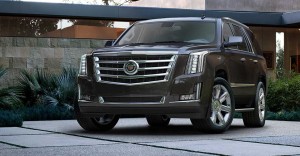
It’s not hard to understand why. The ELR is very expensive (over $75k to start) but very slow. It realistically seats only two. And it doesn’t go very far on its batteries.
The Escalade, on the other hand, costs less ($71,695 to start) is very quick (6.3 seconds to 60, epic performance for a beast this size) seats four adults and three kids – and goes surprisingly far on a tankful of gas. I blitzed down to Raleigh, NC from our place in The Woods of rural SW Virginia – a four hour trip – and still had about half a tank left when I got there.
Sure, it takes about $40 to add half a tank of gas. But unlike the ELR, the Escalade can be refueled in minutes rather than hours.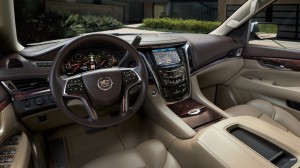
Which would you rather drive?
WHAT IT IS
The Escalade is Caddy’s full-size, ultra-premium SUV. It is a real SUV, too – built on a serious-business steel frame, with the body bolted onto that and the engine (a big V-8 engine) driving the rear wheels or all four of them, your choice.
In addition to being the best-known of the big ‘uns, the Escalade is also the most powerful – by a long shot – and it’s the only one that’s sold in an even bigger version, the ESV.
Well, the Lincoln Navigator also sells in “L” extended form. But the ’15 Nav is two cans short of a six pack, having lost its formerly standard V-8. And its now-optional V-8 produces a puny 310 hp – 120 fewer horses than the ’15 Escalade’s standard V-8.
So, there you go.
Base price for the ’15 Escalade with RWD is$71,695; add 4WD and the price ticks up to $74,295. A top-of-the-line Premium trim with 4WD stickers for $82,795.
The longer ESV version of the Escalade starts at $74,695 for the base RWD trim and runs to $85,795 for a Premium with 4WD.
The most direct-comparison cross-shop – at least in terms of shock and awe value – is probably the Infiniti QX80. It comes in one size only – and it’s 20 hp shy of the Caddy under the hood. But it’s a big ‘un, too. Bigger, actually, than the standard-length Escalade.
Much less expensive, too – just $62,700 to start with RWD and $65,800 with 4WD.
You might also cross-shop the Lexus LX570 – but it’s getting long in the tooth (current model, same as last year’s model) is a smaller vehicle, can’t pull as much – and has a weaker engine. Plus, it costs more than the Caddy – $83,540 to start.
The ’15 Escalade receives its first major update in several years. Highlights include a more visually arresting – and intimidating – exterior (with tall boy taillights that run clear up to the roof) a revised interior and an even more powerful standard V-8 that manages to get slightly better gas mileage than last year’s V- while also getting the new Escalade to 60 even more quickly than before.
WHAT’S GOOD
King of the Road. Period.
Tremendous performance – not terrible gas mileage . . . for what it is (and relative to the competition).
Class leading room up front (headroom and legroom).
Sizes to suit: Big . . . and really big.
$8k price uptick for 2015 vs. 2014.
Pretty to look at but pretty awkward to use “haptic” finger-swipe controls.
4WD system lacks two-speed transfer case and Low range gearing.
Navigator can pull more; QX costs a lot less.
UNDER THE HOOD
All Escalades come standard with V-8 power.
A big V-8.
6.2 liters.
The QX80’s standard V-8 displaces a comparatively small-fry 5.6 liters. And the poor old Navigator – actually, the poor new (2015) Navigator – comes standard with a V-6 that’s only about half the size of the Caddy’s V-8.
Power is up to 420 hp – more standard power than anything else in this class – and not by a little bit, either.
The QX80’s 5.6 liter V-8 comes in second place with 400hp (less than last year’s Escalade). The Navigator’s newly standard V-6 (gack!) takes up a distant third place with 365 hp. It’s optional V-8 – 5.4 liters, 310 hp – isn’t even in the race.
While the Cadillac’s 6.2 liter bruiser almost effortlessly hurls the 5,603 pound Escalade to 60 in a searing 6.3 seconds, the lazy Lincoln requires two full seconds more (8.3) to do the same run.
The QX is more competitively quick: zero to 60 takes 6.8 seconds. But that’s still no threat to the sports car-quick Cadillac.
Adding insult to injury, the ’15 Escalade gets better gas mileage than its smaller-engined, slower-accelerating rivals: 15 city, 21 highway for the rear-drive version – vs. 14 city, 20 highway for the rear-drive Navigator and QX80.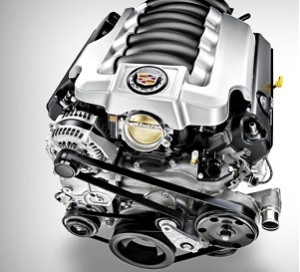
The ’15 Escalade also returns slightly better mileage than the less powerful (and less quick) ’14 Escalade – which posted 14 city, 18 highway with rear-drive and a spectacularly consumptive 13 city, 18 highway with 4WD. The ’15 with 4WD (and 420 hp vs. the old model’s 403 hp) rates 14 city, 21 highway.
Speaking of 4WD:
The ’15 Caddy’s system does not have a two-speed transfer case or 4WD Low range gearing. It is more like all-wheel-drive in this respect, since it operates full-time without the driver needing to manually engage the system by turning a knob or pushing a button or – heaven forbid – pull a lever. The upside is it’s always on – and completely automatic. The downside is you haven’t got the tools to deal with deep/unplowed snow – and probably should think twice before you risk driving onto a grassy field. If the thing sinks into the ground, it’ll be tow-truck time.
The Lincoln Navigator’s optional 4WD system is similarly light-duty, with no Low range gearing. However, the Infiniti QX does offer a serious 4WD system, with part-time 4WD (you choose whether and when to engage the 4WD) and a two-speed transfer case with Low range gearing. This endows the Q with a higher level of off-road capability than either the Caddy or the Lincoln.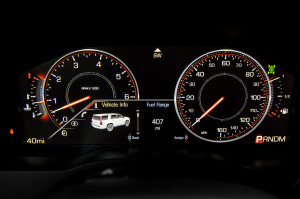
One curious thing is the Caddy’s maximum tow rating. Despite being the most powerful vehicle in this class, it’s only rated for 8,200 pounds – vs. 8,500 pounds for the Q and a very impressive 9,000 pounds for the far-less-powerful Navigator.
Why? I can’t give you a definitive answer, but suspect it has to do with other-than-engine factors, such as durability (and warranty) concerns for the transmission or perhaps the Caddy’s frame isn’t quite as heavy-duty as the Lincoln’s.
ON THE ROAD
Cadillac is determined to brook no competition – and in terms of get up and go, the Escalade wins, decisively. The 6.2 liter V-8’s 460 ft.-lbs. of torque (and 420 hp) is pure delicious overkill. You could probably pull a spark lug wire, run the thing on seven cylinders – and still be the quickest thing on the block. And on the highway, thanks to the six-speed automatic’s deep overdrive gearing, the revs at 75 are just over 2,000 – which makes it feasible to travel almost 550 miles on 26 gallons of fuel.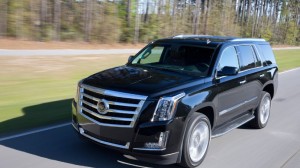
I’ve got nothing but nice things to say about the Caddy’s drivetrain.
It’s suspension, though, is another matter. Though it has both Sport and Comfort modes, the ride is arguably on the over-firm side for a luxury SUV. The problem is probably not the suspension, however. Rather, it is the 20 inch wheels and short sidewall tires the Escalade comes shod with. Oversize “rims” are very trendy but very silly – if you care about how your vehicle rides. There’s only so much an adjustable suspension can do to tamp down the oscillations telegraphed to the vehicles’ occupants by these mondo “rims.” And the “twennies” can be upgraded to ‘twennytwos.” Both are are the rolling stock equivalent of pointing a pistol sideways at your intended target.
The Navigator – which comes with more sensible 18 inch wheels – has a much softer, more luxurious ride.
On the other hand, the Caddy deals with sudden steering inputs much better; it is more controllable – and it handles vastly better.
All the vehicles in this class are lunkers, but the Escalade has a tighter turning circle (39 feet) than either the QX80 or the Navigator (41.6 and 43.9 feet, respectively), which makes it noticeably easier to maneuver in tight confines such as the car-crowded parking lot of a fast food joint. It also sits lower than either of its two competitors: 74.4 inches for the Escalade vs. 78.1 for the Lincoln and 75.8 for the Infiniti. This makes it less awkward to deal with drive-throughs and low-ceilinged parking garages. No doubt, the Escalade’s lower-in-the-weeds stance also enhances its stability at higher speeds.
It is, however, wider than its rivals: 80.5 inches vs. 78.8 for the Nav and 79.9 for the Q. This makes parking slots (designed for cars) seem all the smaller.
I like the capless fuel filler system. It’s convenient – and much less messy, an important consideration when considering a premium vehicle. You will not have to worry about griming up your hands on the gas cap, because there is none. Just push the fuel pump’s nozzle in the hole.
The pump, however, is not under Cadillac’s control.
One thing I did not like is the Caddy’s CUE touchscreen interface. The look is slick – large LCD flat screen at the top of the center stack. But the function is awkward. You can’t , for instance, find the control to change the radio station by feel. You go by look. It is necessary to place your finger exactly on top of the spot for the control on the flat screen, else you might inadvertently swipe something else. This is easy to do with the vehicle moving – and not easy to avoid doing without looking at the screen instead of the road.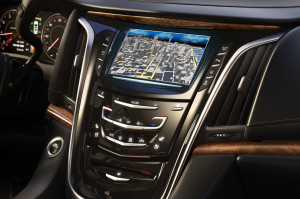
Same goes for the finger-swipe (and tap) “haptic” controls below the CUE LCD display screen, which control the air conditioning temperature and fan speed. These controls are either too sensitive – or not sensitive enough. I found myself spending more time than it ought to have taken to do something that ought to be straightforward, such as adjusting the fan speed.
AT THE CURB
The Escalade is big – but it’s not the biggest.
Not the standard model, anyhow.
At 203.9 inches long, end to end, it is 4.4 inches shorter than the Infiniti QX (208.3 inches) and 4.5 inches shorter than the standard-sized Lincoln Navigator (208.4 inches).
This might just be “just right” sized – big, but not too big. I can vouch for the Q being a bus. A nice bus. But a bus.
It’s a handful.
And if you do want more – even more than the Q – there’s the Escalade ESV. It’s almost two feet longer than the regular Escalade. That’s also longer (by about an inch) than the Lincoln Navigator “L,” too. (And don’t forget: The regular length Lincoln is underpowered; imagine how much more underpowered the longer – and heavier – “L” version is.)
Packaging in the Caddy is also better. You get 45.3 inches of front seat legroom – by far the most in this class (the Navigator has 41.1 inches; the QX80 just 39.6 inches) and plenty of room in the second row: 39 inches for the Caddy, 39.1 for the Nav. The Q has more – 41 inches – but remember the front seat spec.
The Caddy also has much more headroom than its rivals: an NBA forward-friendly 42.8 inches – vs. 39.5 in the Lincoln and 39.9 in the Infiniti.
The third rows in all these rollers are useless – for adults. But the Caddy’s do fold flat – and at the touch of a button. This creates 94.2 cubic feet of space – enough to easily cart home a full-size outdoor gas grille with accessories. The Navigator does have the most total real estate of the three – 103.3 cubes vs. 951.1 for the Q and 94.2 for the Cadillac – but all can carry a gypsy caravan’s worth of stuff. The only difficulty – and this is an across-the-board SUV deficit – being a relatively high load floor. Car-based crossovers (and minivans) have lower floors – and often have more total cargo space, too.
But then, you’d be driving a crossover… or (god help you) a minivan.
The exterior is bolder than ever. Highlights include very tall – and very thin – tail lights whose shape evokes the classic look of Caddys from the late ’50s and early ’60s. Up front, a Mount Rushmore-esque wedge parts the crowd. Cowes the crowd. The massive chrome grille is set off on either side by inverted L-shaped headlights with five stacked individual LED projector bulbs.
“Bold” hardly covers it.
Inside, there’s a new (and driver-configurable) flat-screen dash display similar in theme to what you’d find in an S-Class Mercedes (or a Gulfstream private jet’s flight deck). The secondary control buttons on the steering wheel are white backlit and seem to come alive when you first push the “engine start” off to its right.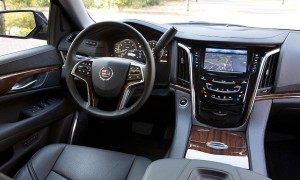
Cadillac wisely carried over the column-mounted stalk gear selector. It is easier to use – and doesn’t waste center console space.
You can order everything imaginable – just about – that might be on a just-signed first-round draft pick’s wish list, including Blu-ray player and power retracting steps with puddle lighting.
But even the “base” model comes with a heated steering wheel (and heated seats), three-zone climate control, power adjustable pedals, Bose 16-speaker audio, five USB ports, the magnetic ride control adjustable suspension and those god-help-your tailbone 20 inch “rims.”
Cadillac hasn’t caved in. Indeed, it has upped the ante. Instead of bending with the prevailing winds of political correctness and downsizing, de-powering or even outright dropping the V-8 from the roster, Cadillac made it even stronger. And kept it standard. Here’s mud in your eye, Captain Planet.
This is a very large part of the Escalade’s appeal. Of Cadillac’s appeal. It is not a wallflower brand. You want something a bit less brazen? Then this one’s not for you.
I dig that.
So do enough other people to keep Cadillac in the black.
At least, for the moment.
My only gripe is the nearly $8k hike in the Escalade’s sticker price. Yeah, it’s a new model and yeah it has more stuff than the previous model. But – damn! – $8k more? That’s almost enough to pay for an economy car to tow behind the Escalade. Or gas for . . . well, the next year anyhow.
On the other hand, it is The King. Nothing in the segment rivals it for power/performance – or testosterone overflow. Who needs Viagra when all you need to do is stand near one of these things?
THE BOTTOM LINE
It makes my life easier when there’s a clear winner in a given segment. If you want the best – the ultimate – this is the one.
Throw it in the Woods?
Spread it via Twitter: LibertarianCarG (they would not let me have “guy”).
And:
We depend on you to keep the wheels turning. If you value alternatives to the MSM, please support independent media. Our donate button is here.
For those not Pay Pal-inclined, you can mail us at the following:
EPautos
721 Hummingbird Lane SE
Copper Hill, VA 24079




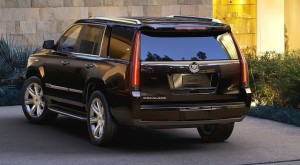
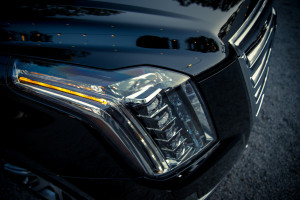




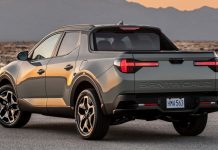



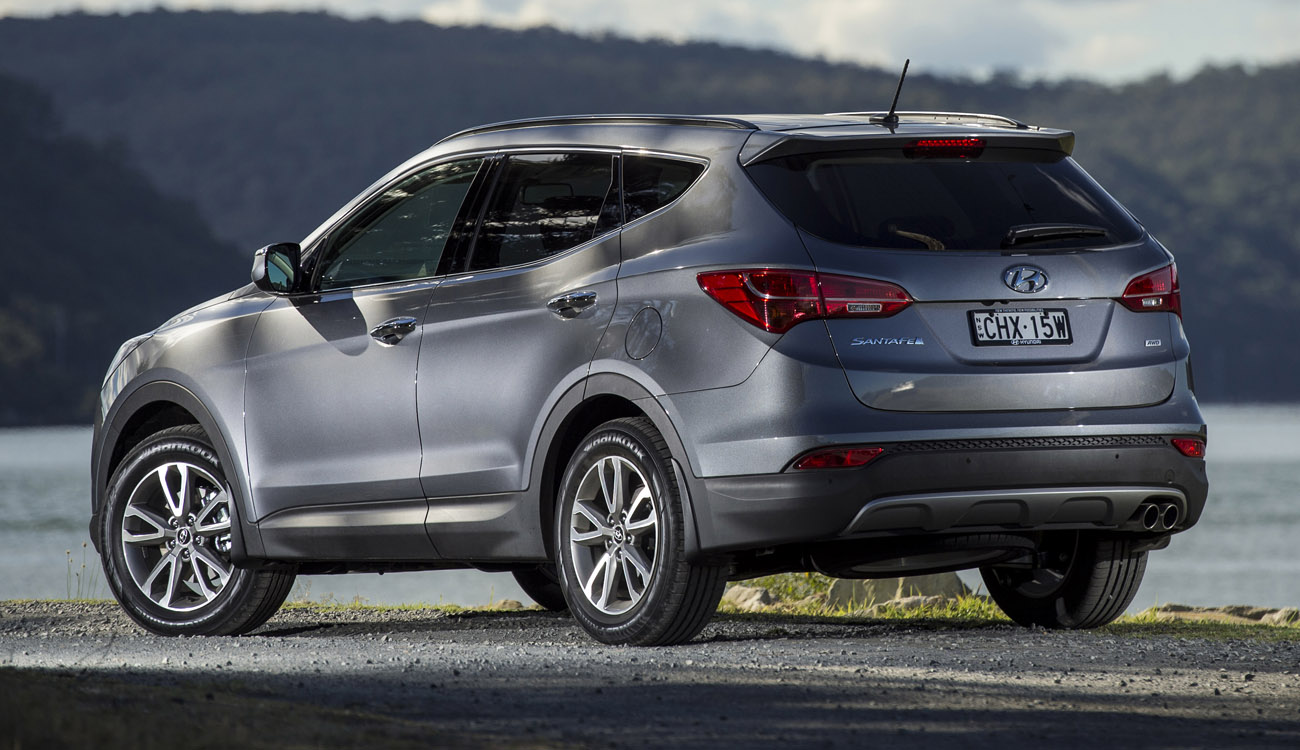
I am afraid I have to agree with many of these posters that the Escalade is merely one of the more egregious examples of bad product design by Govt Motors. It looks ugly and appears to have none of the interior finish and styling that one would expect from a vehicle sold at this price.
I agree with you, Escher – but, the thing does sell.
A few thoughts and bits of info generated by the article and the discussion:
1. Tow ratings – A few months ago I actually tried to figure out how tow ratings are determined for vehicles. Turns out there’s no standardized way to determine tow ratings, industry or imposed by government regulation. Factors that are included in the calculation vary from manufacturer to manufacturer, and there doesn’t seem to be an official published reference to any of them. They’re sort of kept secret, probably so other companies cannot claim shenanigans. So what exactly is used to calculate tow ratings changes, as does how much influence each factor has on the end total. From what I could find, though, some of what is used to calculate these numbers are: frame rigidity (the Escalade’s frame should be light years more rigid than any of its older competitors since it’s based on the new GM truck chassis which is the newest and most rigid), engine power and torque, vehicle weight, axle diameter, suspension geometry, drive system (2WD vs. 4WD), braking capabilities, gear ratios (transmission and differentials) and cooling for engine and transmission. One interesting thing that determines tow ratings that has nothing to do with actual capability is government regulation. Beyond certain gross vehicle weights and tow weights, trucks can move up or down in category, say from light truck to something heavier, and that brings a whole new set of regulations and relieves some others. Thus you’ll get odd tow ratings of 14,900 lbs instead of 15,000 lbs because somewhere there’s a government rule that comes into play once you hit 15,000 lbs. It’s reminiscent of how muscle cars in the 1970s were often down-rated on horsepower b/c of insurance rates being cheaper at lower hp ratings.
Anyway, Ford, GM, and Chrysler are currently cooperatively developing a standardized method of calculating tow ratings so as to more honestly compare trucks. I believe Toyota has signed on as well. Just one more example of an industry coming up with its own self-regulation and standards because of needing to satisfy the consumer rather than because it was mandated by a legislator.
2. AWD vs. 4WD vs. 4-Lo – While it used to be true that not having a 4-Lo transfer case meant that a vehicle was not capable off-road or wasn’t serious, those days are rapidly passing by. Even among serious off-road and truck magazines, they’re having to reconsider this now outdated mentality because there are so many highly off-road capable vehicles coming out that no longer have 4-Lo and many that are AWD only (vs. selectable 4WD). Similar rethinking is going into the body-on-frame vs. unibody discriminations. In reality, the proof is in how well these machines actually perform off road, which often boils down to how well engineered the systems are.
For example, a friend has a first-gen VW Touareg TDI that he likes to play around in the dirt with. He took it up an iced over hill with front, rear, and center lockers fully locked, and it could not crest the top, even with all the torque the TDI created. However, when he opened all the lockers and left it in off-road mode to let the computer redistribute the power based on grip, he had no trouble crawling up and over the same incline a second time. In this case, the computer outperformed a fully locked powertrain.
In reality, 4-Lo is useful only in a very few circumstances and has nothing to do with traction. It has everything to do with gearing down so you can “crawl” over obstacles while keeping engine revs up and power up. Crawl ratios are most useful in rock crawling or in steep inclines where momentum is not an option.
So if a truck would sink into a grassy field and get stuck with AWD, it would get stuck with a 4-Lo transfer case, too. In fact, depending on the quality of the AWD system, it’s very possible that the AWD vehicle will perform better than a fully locked 4WD system in 4-Lo. The latter will have effectively 25% of power at each wheel whereas a good AWD system can transfer, in some cases, over 90% of the power to the one wheel with traction. This is also why AWD systems are generally better than 4WD systems in snow and ice, all other things being equal.
That said, the Escalade’s AWD system is likely not going to be of the same caliber as a Touareg, Cayenne, Range Rover, or Land Cruiser. It’s meant to add confidence in handling heavy rain, snow and ice, and emergency maneuvers. Unless they know how to turn off the traction and stability control systems, an Escalade driver won’t get very far in mud.
3. Government Motors – I grew up a General Motors devotee only because my family was. My grandfather sold the things for 30+ years at the local dealership in nowhere Arkansas. I swore them off after the bailouts, as I did Chrysler and Ford (and don’t say Ford “didn’t take a bailout” because they did, only under a different program than TARP). I can no more contemplate going back to GM than I could going back to an ex-wife that cheated on me and had no remorse about it, actually claiming that it was good for our marriage (sort of an extreme “broken window fallacy”).
At this point, I’m hoping they crash and burn, literally. I hope the recall-a-palooza going on takes them down hard. Chrysler is already a lost cause, more Italian now than American, and Ford doesn’t make anything interesting any more outside of possibly the Mustang. I’d rather drive a Daewoo than be seen in a GM socialist-mobile at this point.
4. Size and utility – Some people wonder why anyone would want such a big vehicle. Having grown up driving SUVs before they were popular, I can tell you that SUVs larger than a Grand Cherokee are, in fact, quite useful. They generally tow more, they carry more inside (more than any crossovers, really), and are able to carry you and 4 friends and all your gear down to the hunting cabin in the woods in relative comfort.
However, there’s a number of problematic trends over the past two generations that are neutering that utility. First, they have lost a lot of their off-road chops. With low-hanging air dams, running boards, fender bits and pieces, wires and hydraulic lines dangling down below axle levels, etc. they have lost their approach and departure angles and they are easier to high center. Plus, as expensive as they have become, a scratch or a dent may end up costing a lot and doing much more damage than you’d think. You can’t very well put a Hi-Lift jack under the front fender of an Escalade and pick it up or you’ll rip the whole fender off. These things are delicate.
Lastly, and most importantly, the interiors are shrinking. While they maintain or expand their exterior dimensions, they are having to add airbags, Blu-Ray players, screens, third row seats, climate controls, cameras, integrated coolers, etc. everywhere inside. These things take up valuable cargo room. My 1999 GMC Yukon (good truck, BTW), was rated at 118 cubic feet with rear seats folded. This Cadillac Escalade is limited to only 94 cf despite being longer, wider, and higher than my old Yukon. That’s a 22 cf difference, which amounts to a large car trunk by itself. So even as they get larger outside, they are losing utility inside. All of this serves to undermine the inherent strengths of such large SUVs and, in reality, and prices have moved them out of the realm of “utility” and into the realm of ostentatiousness, thus the exaggerated styling cues.
5. Badge engineering – SUVs continue to be among the most profitable of all vehicle classes to build. The amount of profit to be had is extremely high compared to how much it costs to build. The higher the trim level, the more profit there is.
I’ve been inside the new Escalade, as well as a GMC Denali and a Chevy Tahoe. Eric’s right in that you’ll get a much better engine in the Denali and Escalade, and you’ll get a few extra baubles and niceties. Yet in reality, aside from engine performance, there is minimal actual difference in interiors and sensation between a loaded out Tahoe and an Escalade. The Tahoe may even ride better because it doesn’t have ridiculously large rims on it. There is certainly not enough material difference in terms of cost of manufacture to justify half the price difference. It actually costs about the same to make both engines, so all you’re paying for is a few extra electronic bits, some marginally nicer leather, and some bits of wood.
If you get inside an Escalade and then get inside a Mercedes GL, the level of comfort and class are worlds apart. The Escalade feels cheap, plasticky, and shoddy whereas the German feels sumptuous and solid. No wonder the GL outsells both Escalade and Navigator combined. It’s a MUCH better bargain. It even has an off-road package available and has been heavily tested off-road.
If you want an Escalade, wait a year or two and get a used one. Let someone else take the $30k depreciation hit. Better yet, get the Denali. It’ll be even cheaper and nearly as nice inside.
Highly informative article.
Useful information even for those with no interest whatsoever in this category of motor vehicle. Provides a valuable point of reference.
I for one, know I would never want any of the vehicles in this category. To me, they are grossly oversized, grossly overweight exercises in excess. They represent sloppy design and engineering. No effort whatsoever made in the direction of efficiency.
Take a car like the Honda FIT. It is tiny on the outside, huge on the inside. Tremendous ingenuity was required to achieve this. Ditto the MINI. I admire that.
Cars such as the Cadillac Escalade are huge on the inside, but they are even “huger” (?) on the outside. Just lazy. Contemptible.
As far as the SUV form factor goes, I see no reason for anything larger than the original 1980s version Jeep Cherokee.
Just one car buff’s consumer preference of course. Not dictating what must be.
Thanks, Bevin!
These things aren’t my cup of tea, either – but at least they exist because of genuine market demand, unlike the Volt (or ELR)!
My favorite vehicle of this type was the original Jeep Wagoneer. It was luxurious and capable but not too large or too over-the-top.
Dear Eric,
Agree. The early Jeep SUVs (and early Land Rovers) were straightforward vehicles that really were “utility vehicles.”
Fortunately they are not subsidized with my tax money — that I know of!
International TravelAll
Dear Eric,
Many years ago I remember reading an advocate of motorcycles arguing,
“I only weigh 180 lbs. Why do I need a 4000 lb. vehicle to move me around?”
I never became a motorcycle buff because I was afraid of being side-swiped by clovers changing lanes without looking.
But his point stuck in my head. As a result I always tried to buy relatively light weight, efficient cars.
Colin Chapman took the principle of light weight to maximize both performance and handling to its extreme. He even took it to the point where it undermined the long term durability of his Lotus cars.
But even if one does not go that far, I’ve always thought that it still makes sense to maximize power to weight ratios by reducing weight first, and increasing power second.
I read that Mazda is attempting to do that with the 2015 Miata.
So what’s the real difference between this & a loaded Suburban?
Hi Bill,
Mostly, styling and amenities – some features available in the Cadillac are not offered in the Chevy. However, there is one very big difference: Under the hood.
The Chevy comes with a smaller, much less powerful 5.3 liter V-8.
This is best in its class alright. The UN Agenda 69 chastity engineered abstinence class.
Are there no vehicles still in production like this ’63 Impala ? Is every sedan mandatorily accoutremented with the 100,000 mile purity package?
General Motors to discontinue front bench/wench seat after 2013 Impala
Somebody please open an auto aftermarket shop and salvage these eunichized idiot boxes back into mass market fuck wagons for getting your kicks on Route 66 as our Good Ford always intended.
Caddy can’t get rid of the Escalade. No drug lord or lottery winner would be seen in anything less.
Hi Gary,
They’re not for me, either – but they are popular!
I don’t have any objection to the thing because it is a market-driven vehicle.
Now, the ELR…
@Eric – A few years ago I had a brand new 4X4 GMC Denali when it was basically the same as the Caddy. What a rotten cheap junker it turned out to be, and I am a GM fan. And for $60K the dealer, where it lived most of the time getting fixed, treated me like an illegal alien. No mas any new GM for me.
Morning, Gary –
Well, there’s that!
Some might argue – not without merit – that here we have another example of badge-engineering. Take a $28k Tahoe… give it a Cadillac front clip and tail lights, wrap it in leather and chrome… then sell it to the morons for twice that!
@Eric – A question for you. Prior to the Denali disaster I had bought a new Ford Bronco II in the 80’s that was nothing but trouble. After a lot of BS with the dealer and the Ford reps they were forced to give me my money back under the lemon law. Since the Denali (which I did sell for cash to a drug dealer – but that is another story) I have sworn off buying a brand new car. My thinking is that a vehicle that is a couple of years old & thoroughly checked out is a better way to get a set of wheels. What is your take on that strategy?
Hi Gary,
Here’s the thing with used vehicles, as I see it: They’re each unique “individuals” – even identical make/model/year vehicles. Because each has led a different life; been treated better (or worse). Serviced properly (or not). The one you looked at this morning might be a much better choice than the one you looked at this afternoon, because the one you looked at this morning was always garaged, never driven hard and always well-maintained whereas the one you looked at this afternoon was parked outside, driven hard and not maintained decently. Mileage – and asking prices – will also vary from vehicle to vehicle.
In brief, there are more variables – and so, the odds of getting stuck with a bad apple are probably higher. With one qualification: If you are someone knowledgeable about cars and know what to look for in terms of red flags, then you are in a position to avoid the bad apples – and take advantage of the “depreciation discount” on a used vehicle and save yourself a pile of money.
Other tips/things I’ve figured out over the years:
* Avoid the first year of any new model. There are always bugs – and sometimes big bugs. These usually get discovered – and sorted out – by the second or third year of production.
* Due diligence: New or used, search the Forums and such like for owner complaints about the model you’re thinking of buying. CR and Automotive News are good places to look also.
Actually, another large buyer is the Federal Government. Got to armor ’em up though so that The King (literal king, not the king of the road Eric refers) can terrorize pedestrians on the streets of DC.
https://www.youtube.com/watch?v=xXIMdP2zvpA (counted 2 in this motorcade).
More “Do what ah say, not what I do, slave!” mentality.
“And the “twennies” can be upgraded to ‘twennytwos.” Both are are the rolling stock equivalent of pointing a pistol sideways at your intended target.
Gnomesayin?”
At your best, you are THE BEST at turning a slick phrase!
Now back to the Escalade…..at this price point it is the best in class. But that’s still a lot of money. And it’s re-sale price is going to go down faster than….well, I won’t even try to match your wry verbiage. 😉
So, if I wanted a big-assed, high performance, luxury SUV, I’d skip the trip to Europe for just one season. Then I’d have enough money saved up to buy the Mercedes 550 GL.
Hi Mike,
Thanks for the hat tip!
I thought about adding something about the Mercedes as an alternative, but – as I see it (and what I see might be totally off base) the Benz is oil to the Caddy’s water. Yeah, they’re both large SUVs. But “bling” is not the basis for the Benz. I don’t think I’ve ever seem a cRap star or NBA player “stylin'” in a GL. Of course, it’s also AWD-only (no RWD version) and it offers a diesel engine as well as (much less powerful) V-8.
Which would I personally rather have, if I had to pick? I bet you know the answer!
You’re right Eric. The GL can also be had with a diesel engine, or less powerful gas V-8s, or an even more powerful gas V-8, the GL 63 AMG.
If we’re not picking the 550 GL…..Then I think I know which one you would rather have. And I bet you can also guess which one “I” would choose. 😉
There’s at least one rumor that the Escalade could get a 3-liter turbodiesel, and that might save it from CAFE.
Not sure where GM would get such an engine – they sold their share of VM Motori to Fiat, and those motors are now to be found in Chryslers and Jeeps.